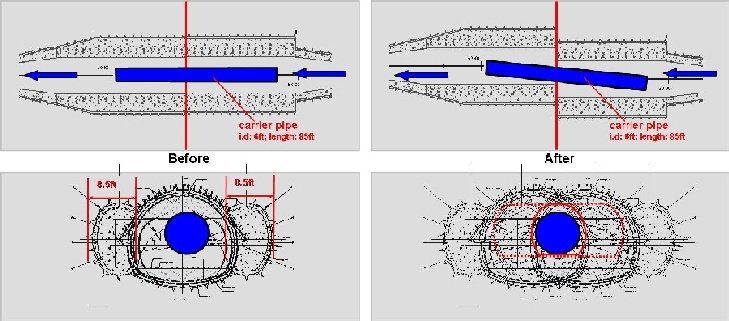Seismo Blog
Of Tunnels and Earthquakes - Part II
Categories: Hayward | Water Tunnel | Earthquake Faults and Faulting | Preparedness, Risks, and Hazards
December 19, 2008
The Claremont Tunnel through the Berkeley Hills is a major artery of the East Bay Municipal Utility District's water supply system (EBMUD). It delivers drinking water to more than 800,000 people living in East Bay communities from Oakland to Richmond. Damage to the tunnel by a major earthquake on the northern section of the Hayward Fault would cause more than "just" economic losses of $1.9 billion (see blog December 15, 2008). A study commissioned by EBMUD more than 10 years ago concluded that a quake would disrupt water delivery for weeks, reduce fire fighting capabilities, and lead to severe water rationing for up to six months during tunnel repairs. To avoid service disruptions, EBMUD, the tunnel's owner, decided to make the tunnel safe and keep water flowing even if an earthquake of magnitude 7 hits the area.
Unbeknownst to most of us, miners and engineers have been digging through the Berkeley Hills near the landmark Claremont Hotel for the past two years. In June 2006, they started the project with a 480 ft long access tunnel into the fault zone. When that was complete, they added a bypass tunnel parallel to the old tunnel. This 1600 ft long bypass is 10 ft across except in the 100 ft long section where it crosses the fault zone. There it is 17 ft in diameter. This section is also specially reinforced. It has a concrete liner more than 2 ft thick, and more than 20 engineered breaking points along the tunnel which are designed to break and shift during a major earthquake. Here the water is carried through an 85 ft long steel pipe with a diameter of 6 ft and a wall thickness of 3 inches. It rests on pipe guides. (See "before" picture.)

The design of the new EBMUD Claremont Tunnel in the Hayward Fault zone. (Picture courtesy of D. Lee, EBMUD.)
In constructing the bypass tunnel, the engineers assumed the maximum offset during the earthquake would be 8.5 ft or less. If the tunnel lining and the pipe guides shift that much during the quake, the pipe will stay intact (see "after" picture). It will continue to deliver up to 130 million gallons of pure drinking water to users. Above ground, meanwhile, the quake might have wreaked havoc. EBMUD finished the project this summer and its customers west of the Berkeley Hills now have a reliable water supply.
Another water agency, San Francisco Public Utility Commission (SFPUC), which supplies drinking water to the city from Hetch Hetchy Reservoir, will also engage in a major upgrade project. Having completed many smaller improvements to their system, they will open bids next spring for a new, 5 mile long water tunnel under the bay near the Dumbarton Bridge. (hra024)
BSL Blogging Team: Who we are
Recent Posts
-
: Alerts for the Whole West Coast
-
: Destruction in the Eastern Aegean Sea
-
: An Explosion in Beirut heard all over the Middle East
View Posts By Location
Categories
- Alaska (3)
- Bay Area (24)
- Buildings (3)
- Calaveras (4)
- California (13)
- California ShakeOut (3)
- Central California (4)
- Chile (4)
- Earthquake Early Warning (10)
- Earthquake Faults and Faulting (44)
- Earthquake Science (3)
- Haiti (3)
- Hayward (12)
- Indonesia (4)
- Induced Seismicity (3)
- Instrumentation (18)
- Italy (6)
- Japan (7)
- MOBB (3)
- Mendocino Triple Junction (5)
- Mexico (7)
- Nepal (3)
- North Korea (5)
- Nuclear Test (5)
- Ocean Bottom Seismometer (3)
- Oklahoma (4)
- Plate Tectonics (18)
- Preparedness, Risks, and Hazards (16)
- Salton Sea (3)
- San Andreas Fault (14)
- Seismic Waves (13)
- Seismograms (4)
- ShakeAlert (3)
- Southern California (5)
- Surface Waves (3)
- Today in Earthquake History (20)
- Volcanoes (4)
- subduction (3)